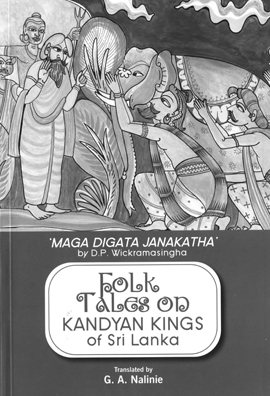Back to the roots
Folk Tales on Kandyan
Kings of Sri Lanka
Translated by G.A.Nalinie
Sarasavi Publishers,Nugegoda
Reviewed by G.A. Mathupema
Inculcation of traditional awareness of the country in which you
live, is a vital necessity in education which is very much felt when you
consider the type of education imparted to the children in international
schools in this country, in which school syllabuses in England are
followed.
 Children come to know the history of England sans any knowledge of
the history of their mother country. Children come to know the history of England sans any knowledge of
the history of their mother country.
These children are very familiar with king Arthur and the Knights of
the Round Table; but they know next to nothing about King Rajasinghe II.
The children who study in these institutions become aliens in their
mother country. In fact, the need of traditional conditioning in
literature has been emphasised by the celebrated critic T.S. Eliot.
This need has been considerably fulfilled by the translation of the
book of Magadigata Janakatha by D.P. Wickramasinghe which has been done
by the veteran writer G.A. Nalinie.
Although I referred to this book as a translation, it is rather an
adaptation in which she has modified the original work, seeing to the
needs of the children in their history education. Moreover, she has
added her remarks on various incidents and issues that are presented in
the original work.
Children
She is well qualified to this task being a graduate in history of the
Kalaniya University and was a resource person the National Institute of
Education, Maharagama.
There are a good number of books to her credit some of them involving
history. In most of her books there is a keen sense of the needs of the
children, particularly in history.
It is a pity that the children who know about the Knights of the
Round Table in the history of England know next to nothing about King
Rajasinghe II.
This heroic deeds have been profusely given in his book. King
Rajasinghe II was travelling in rural areas in disguise. Once he was
feeling very hungry and stepped into the house of a poor old woman.
She gave him the hot milk rice to eat. In his hunger, he was
hurriedly picking up a morsel here another there.
The old dame observing this told him, that the way how he was eating
hot milk rice was similar to the war activities of King Rajasinghe II.
She advised him to eat systematically not knowing that he was the
king himself. The king took her advice seriously and applied it in his
war tactics. He won the battle and summoned the old dame to the palace
and rewarded her profusely. On another occasion the king had been
advised by an old man.
Impression
While perusing this book, I got the impression that Sinhala kings of
yore had been in constant touch with common people. A wide variety of
kings has been presented in this book. Some are noted for their bravery,
others for their humanity and yet others for their humbleness.
Some stories are noted for their anthropological value e.g. Story
number one and number 16. In these stories, the origin of the name
Senkadagala and Kundasale has been given.
The conscientious motives of the writer in bringing out a book of
this nature should be appreciated. She had the sole motive of edifying
the future generation, being aware of the spectacular and grand
traditions of the past.
The book is written in lucid language and suit the children of post
primary level. Also it is good reading for adults.
|

